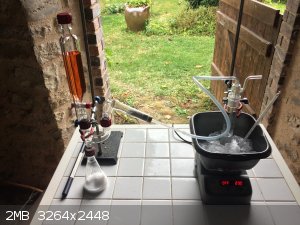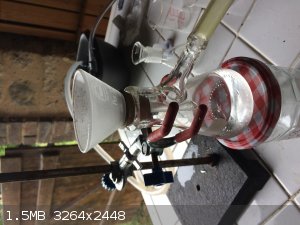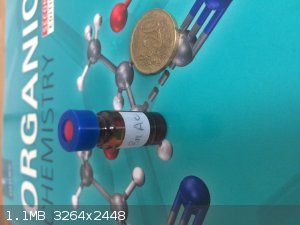Keras
National Hazard
   
Posts: 769
Registered: 20-8-2018
Location: (48, 2)
Member Is Offline
|
|
Acetyl chloride via acetonitrile + acetic acid + HCl (report)
Folks,
I tried to reproduce the acetyl chloride synthesis as outline in the Chemplayer video. As explained in this video, the idea of synthesising acetyl chloride from acetic acid and acetonitrile harks back to the
beginning of the 20th century, and the video states the reference, whose original French version can be found easily (at least for those who speak
French) on the website of the Bibliothèque nationale.
That being said, Chemplayer’s attempt was only partly successful, and they suggest at the end of the video some ways to improve the final yield. On
the other hand, Wikipedia states that the yield cannot exceed 30%. Following Chemplayer’s suggestions, I gave a go at the reaction under the following
conditions:
— The gaseous HCl generator was set up according to Chemplayer, 130 g of NaCl on which was dripped around 250 ml of sulphuric acid based drain
cleaner (label says 60 to 70% concentration) ;
— The output of the generator was led to the main reaction flask through a calcium chloride drying tube to remove all possible traces of moisture
(the salt used was low-grade table salt, so not expected to be anhydrous) ;
— The main reaction flask is made of a Drechsel bottle, where HCl gas bubbles through the reaction mixture. This mixture is made according to
Chemplayer’s original recipe, except that all volumes have been halved, for Chemplayer stated that they interrupted the reaction while there was
still HCl being absorbed in the medium; I therefore decided to use a huge molar excess of HCl. That gives about 21 mL of acetonitrile and 24 mL of
acetic acid.
The Drechsel bottle was placed in an ice + salt bath. At no point during the absorption did the temperature rise over -10 °C. The mixture was
constantly stirred during the addition (magnetic stirring) (see picture).
The dropping funnel was adjusted for a slow dripping rate and the addition began. It took about one hour and half before fumes of HCl began to appear
at the output of the Drechsel bottle. At that time, the solution appeared to be saturated with hydrogen chloride, so the tube was disconnected, the
liquid transferred to a small capped bottle and left to warm for a couple of hours.
Meanwhile, there was still a lot of hydrogen chloride escaping the generator, so the Drechsel bottle was washed and its contents replaced with ~ 80 ml
of 23% commercial hydrochloric acid. I then used the HCl generator to increase the concentration of hydrochloric acid until I reached saturation (d ~
1.2, corresponding to circa 38 to 40% HCl w/w: the acid was cooled in the same ice bath and absorbed more HCl than it would have at r.t.). It is
advisable to place the HCl generator over a source of heat (heating mantle) to get the most of it, as the reaction of sulphuric acid with salt tends
to peter out pretty quickly at r.t. (no real heat is released when the salt is dry). When heated, on the contrary, the reaction is quite vigourous and
gives off a lot of HCl. If anhydrous HCl is needed (obviously not the case if you only intend to make concentrated hydrochloric acid), a calcium
chloride trap is absolutely necessary, as heating the sulphuric acid over 100 °C will release water vapour, as evidenced by condensation over the
cooler parts of the glassware.
Also mind the increase of volume when you absorb HCl gas. The final volume of 40% w/w HCl was 100 ml circa. Concentrated HCl fumes a lot, so handle it
in well ventilated areas.
After the hydrochloric solution was saturated, the contents of the HCl generator were neutralised and disposed of (mainly sodium sulphate and
bisulphate). The hydrochloric acid was stored in a 100 ml high quality bottle (Duran or Pyrex type) with a ’basic’ blue threaded cap (no need for
PTFE lining as long as the bottle is well closed).
Back to the main reaction. After two hours at r.t. the capped bottle was placed in the freezer at -20 °C and left overnight. Next morning, the bottle
was full of crystals, much more than what Chemplayer got (or about the same amount, but the volume of liquid being less, the overall impression is
that there are much more crystals). The contents was vacuum filtered and washed with 20 ml of -20 °C cooled diethyl ether. The crystals were put in
an evaporating dish and left to dry. If anyone knows how to test those for acetamide, be my guest – I think they could be hydrolysed to etylamine
using a sodium hydroxide solution under reflux, but maybe there’s a simpler and quicker reaction that would evidence it (Hoffman rearrangement to
methylamine?).
The liquid was setup for distillation. Given the small amout of it (~ 30 to 40 ml) it was distilled using a short-path apparatus.
And that’s where the fun began! :p
First off, the solution releases a lot of HCl, until it reaches about 100 °C. So, once again, be prepared to fight the fumes off. That said, all the
temperature plateaus are off. The mixture is quite complex, consisting of, in increasing order of b.p.: diethyl ether (used for extraction), acetyl
chloride, and then unreacted acetonitrile and acetic acid. As expected, diethyl ether comes first, but at about 50 to 55 °C, which is well above the
expected b.p. (~ 30 °C). It seems that all products are contaminated with dissolved HCl, and that increases the b.p. significantly, as the vapour is
no longer pure. Once diethyl ether has been removed, the solution stops boiling – there is a clear pause here – then resumes at about 70 to 74
°C, at which point I collected around 15 ml of what should be acetyl chloride with extra HCl dissolved (compare theoretical b.p. 62 °C). There is
another pause, then something else (acetonitrile, probably) passes at about 95 °C, then what’s left in the flask assumes a yellow colour (whereas
it was prefectly colourless up to that point). I stopped there, and discarded the rest after neutralisation (unreacted acetic acid).
It is pretty difficult to identify the compounds, especially because there’s so much HCl dissolved that every attempt to use smell is bound to
overload your nose with hydrochloric acid. The first fraction still has a characteristic smell of diethyl ether. The thrid doesn’t seem to smell
anything. I assumed it was adulterated acetonitrile given the recorded b.p.
As for the second, I tried to test for the presence of acetyl chloride by mixing drops of it with alcohols in order to form esters, after
neutralisation of the resulting mixture with sodium bicarbonate. The fact is, I definitely got some esters (both with benzyl alcohol and standard
ethanol), but there’s also definite presence of acetic acid. I’m not sure how I can characterise acetyl chloride, especially if the solution it is
in is contaminated with both HCl and acetic acid. If anyone has a clue…
Overall, it’s difficult to assess the yield of the reaction, because acetyl chloride is not isolated (at least after a single distillation). The
second fraction, which I assume contains most of it, is about 15 mL. Unreacted products are on the order of 10 mL. The esterification tests do not
seem to give off a lot of HCl, as indicated by the quite low amount of bicarbonate needed to quench the acidity. But, given the amount of reactant
used (~ 1 to 2 mL), that doesn’t mean much. I have a small vial (see picture) with probably relatively pure Bn Ac, if smell serves, obtained by
reacting the second fraction with BnOH, neutralising with bicarbonate solution and collecting the upper organic fraction (no further washing). I’ll
try and analyse it using TLC.
So at the end of the day, I’m convinced this can probably work, but extra care must be taken. I would recommend the same setup, but using fractional
distillation instead. That might give better plateaus, at the expense of lost product. Maybe letting the initial solution a bit longer at r.t. before
freezing it, and swirl regularly. 15 mL of product is not such a bad yield given the low volumes used. Redistillation could probably purify the
product further, given that about all dissolved HCl has been driven off. I might attempt this with what’s left of the product after my various
experiments.
Please let me know if you want to attempt this yourself, I’ll be happy to discuss your results.
  
[Edited on 23-8-2021 by Keras]
|
|
|
Fery
National Hazard
   
Posts: 990
Registered: 27-8-2019
Location: Czechoslovakia
Member Is Offline
|
|
Keras - beautiful and congratulation!
Do you plane an acetylation of some aromatic compound (Friedel-Crafts with benzene / toluene / naphthalene) too? From acetate esters perhaps the best
are benzyl, amyl, isoamyl, octyl acetates. You already obtained benzyl acetate. Amyl = pear, isoamyl = banana, octyl = orange. These esterifications
release HCl so its presence in you product before the reaction does not mind. Or reaction with salicylic acid to acetylsalicylic acid (but here
usually pyridine is added to neutralize HCl, maybe works without pyridine)?
How much wet was CaCl2 you used for dehydratation at the end of hydrogen chloride gas generation? I'm asking only because if some H2O passed it
further, it would lower the yield and acetic acid would be produced. If no water passed it, then you should have only acetyl chloride + acetamide
without contamination with acetic acid (well a little of air moist enters when disconnecting the apparatus and pouring product among various
flasks/vessels).
|
|
|
Keras
National Hazard
   
Posts: 769
Registered: 20-8-2018
Location: (48, 2)
Member Is Offline
|
|
Thanks!
Quote: Originally posted by Fery  |
Do you plane an acetylation of some aromatic compound (Friedel-Crafts with benzene / toluene / naphthalene) too? From acetate esters perhaps the best
are benzyl, amyl, isoamyl, octyl acetates. You already obtained benzyl acetate. Amyl = pear, isoamyl = banana, octyl = orange.
|
I will try other esters, but I have a limited choice of alcohols. Isoamyl I have, propyl, isopropyl and isobutyl. Octyl I could maybe try to make, but
I don’t see really how (Butanol → bromobutanol → organozinc?)
Quote: Originally posted by Fery  |
How much wet was CaCl2 you used for dehydratation at the end of hydrogen chloride gas generation? I'm asking only because if some H2O passed it
further, it would lower the yield and acetic acid would be produced. If no water passed it, then you should have only acetyl chloride + acetamide
without contamination with acetic acid (well a little of air moist enters when disconnecting the apparatus and pouring product among various
flasks/vessels). |
It wasn't wet at all. The granules were quite dry and nowhere sticky. Actually, I sacrificed them, but in hindsight I could probably have recycled
them for some low grade application. The weather was very humid, though, so it’s not totally absurd to suppose that moisture has reacted with the
chloride. In any case, I was stupid not to have attempted a second distillation. Now, with the back-to-school season, I’m stuck for a while and
I’ll have to wait a bit before having an opportunity to get back to my lab. :/
|
|
|
horuse10
Harmless

Posts: 17
Registered: 12-11-2013
Location: France
Member Is Offline
Mood: No Mood
|
|
Why not refluxing your product before distilling it ?
It will degase HCl from the reaction mixture and will probably help for the distillation
|
|
|
Keras
National Hazard
   
Posts: 769
Registered: 20-8-2018
Location: (48, 2)
Member Is Offline
|
|
Quote: Originally posted by horuse10  | Why not refluxing your product before distilling it ?
It will degase HCl from the reaction mixture and will probably help for the distillation |
That’s not a bad idea. But one must be cautious that no side reaction happens during refluxing, though.
|
|
|
horuse10
Harmless

Posts: 17
Registered: 12-11-2013
Location: France
Member Is Offline
Mood: No Mood
|
|
You can although just bubble some inert gas in but i think this would be more detrimental to rendement if you don’t have à very cold condenser
(dry ice) !
If side reactions have to occurs they probably although exist when you distilling your product
|
|
|
|